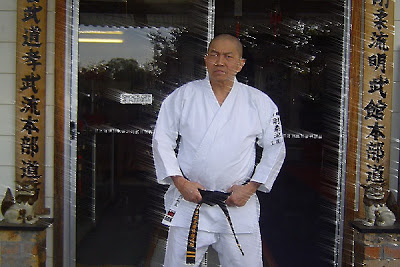Karate is a Japanese word meaning "Empty Hands" indicating that Karate is a Martial Art that does not require weapons other than the parts of the body, but, also means that the practitioner of Karate should strive to empty his/her mind of aggression. Originally, Karate was a method of unarmed self-defence developed in the Okinawan Islands from various techniques introduced from mainland China, as well as local innovations up until the late 19th century, the various karate techniques were practiced and taught within relatively small regions. Example: A particular technique would be taught in one village and never revealed to outsiders. After 1900, great interest was shown in teaching karate to larger groups of the general public and certain karate experts developed distinct 'styles'. In the 1920's, an Okinawan school teacher, Gichin Funakoshi, introduced an organized method of karate to Japan, which became immediately popular. The art of Karate is a system of combat developed on the island of Okinawa. Karate may allow you to defeat an opponent by the use of striking and kicking. The students practice hard physical training to develop fighting skills.This training requires strenuous physical and mental discipline. Karate helps with the development of a strong character and builds a feeling of respect toward our fellow man. The study of Karate, therefore, may be valuable to all people, male and female, young and old alike.
The literal meaning of the two Japanese characters which make up the word Karate is "empty hands." This, of course, refers simply to the fact that Karate originated as a system of self-defense which relied on the effective use of the unarmed body of the practitioner. This system consisted of techniques of blocking or thwarting an attack and counter-attacking the opponent by punching, striking or kicking. The modern art of Karate has developed out of a thorough organization of these techniques. As a physical art, Karate is almost without equal. Since it is highly dynamic and makes balanced use of a large number of body muscles, it provides excellent all-around exercise and develops coordination and agility.
Karate as a means of self-defense has the oldest history, going back hundreds of years. It is only in recent years that the techniques which have been handed down were scientifically studied and the principles evolved for making the most effective use of the various moves of the body. Training based on these principles and knowledge of the working of the muscles and the joints and the vital relation between movement and balance enable the modern student of Karate to be prepared, both physically and psychologically, to defend himself successfully against any would-be assailant. Many girls and women in Japan have taken up Karate because, in addition to its usefulness as self-defense, it is especially good for the figure. It is widely practiced by both children and older people as a means of keeping in top physical condition, and many schools are promoting it as a physical art among their students.
Western (non-Japanese) students may be interested to know that the Japan Karate Association emphasizes Karate's character-building aspects, in which respect for one's opponent (sportsmanship) is the cardinal principle. The maxims which are taught to the students can be summarized in the following five words.
Present day Karate is categorized into four parts -- physical conditioning, self defense, mental conditioning, and a sport. Although its origin is obscure, a popular story prevails that credits the Indian Priest Daruma or Bodhidharma (525 A.D.) with its birth. However, other great men such as Hua T'o (190-265 A.D.), a brilliant doctor, and Yuen Fei, a popular general of the Sung Dynasty, (960-1275 A.D.) are also considered forefathers of Karate.
Karate was originally known as 'Kenpo', meaning 'First Law'. From China it crossed over to Okinawa, where known as 'Te', it consisted mostly of hand movements. In 1923 the Okinawans changed the Chinese character to a Japanese character. Thus, the meaning changed from 'hands of China' to ' empty hand'. This transition assuredly brought about a deeper meaning to the art in which the spiritual overcame the physical. As a sport, Karate has a relatively short history. Contest rules have been devised, however, and it is now possible to hold actual matches as in other competitive sports. because of the speed, the variety of techniques, and the split-second timing it calls for, many athletic-minded people have come to show an interest in competitive Karate and there is every indication that it will continue to grow in popularity. Two experts form Okinawa, Kenwa Mabuni and Gigen Funakoshi introduced their techniques to Japan in 1916. Their aim was to promote Karate as a sport throughout Japan.
Before its introduction to Okinawa, many styles of the art existed throughout China. Each style or system was generally noted for a distinct feat --- developing the tiger claw, butterfly kick, panther punch, etc. In addition, the various systems jealously guarded their techniques and trained in secret. Among the systems of Southern China stemming from the Shaolin or Shorinji temple, were Hung, Liu, Ts'ai or Choy, Li and Mo. Other Cantonese as well as northern systems have found their way to the United States. In the last seven decades, the techniques have been modified into distinct Japanese styles Shoto-kan, Shudo-kan, Wado-ryu, Chitsoe-ryu and others. Many of these styles are currently taught in the United States and are often modified into styles more suitable to American methods of self defense. Thus the art of karate is constantly undergoing improvement and revision.






0 Comments::
Post a Comment